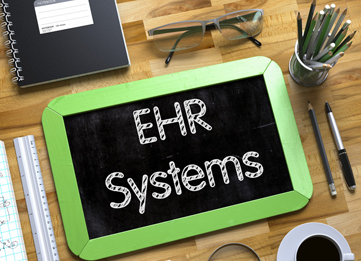 In March 2017, 67% of all providers reported using an electronic health record (EHR), a 1% increase over September 2016, according to SK&A, a leading provider of healthcare information solutions and research. However, while EHRs offer many benefits, surveys show that they continue to be a source of frustration as most physicians find EHR data entry a major challenge. Medical transcription companies help providers to manage patient electronic records with EHR-integrated solutions. Nevertheless, switching EHRs is a growing trend among physicians. A Kalaroma Information survey on the electronic medical record (EMR) market in 2017 found that many physicians and hospitals were ready to switch EHR vendors.
In March 2017, 67% of all providers reported using an electronic health record (EHR), a 1% increase over September 2016, according to SK&A, a leading provider of healthcare information solutions and research. However, while EHRs offer many benefits, surveys show that they continue to be a source of frustration as most physicians find EHR data entry a major challenge. Medical transcription companies help providers to manage patient electronic records with EHR-integrated solutions. Nevertheless, switching EHRs is a growing trend among physicians. A Kalaroma Information survey on the electronic medical record (EMR) market in 2017 found that many physicians and hospitals were ready to switch EHR vendors.
The main problems that physicians report with EHR systems include: functionality or the EHR’s ability to decrease workload, dissatisfaction with ease of use and software platform, cost and financial losses, and poor customer service. The American Medical Association (AMA) reported that a survey published in the January 2017 issue of Family Practice Magazine found the top reasons for switching EHR systems as:
- Gain added functionality
- Achieve meaningful use
- Get better usability
- Find better support and training
- Consolidate multiple EHRs
However, providers also said there are several challenges when it comes to changing their EHR system. About 80 percent of respondents reported that the biggest challenge was the time investment required to switch EHRS, and 70 percent cited productivity loss as the major challenge. Many providers also said that learning how to use a new EHR could be a big challenge and that switching was financially burdensome.
Implementing a new EHR system doesn’t mean just implementing the software. Once the software is in place, it will take several months for physicians to adjust the new system for their day-to-day practices, and they should be prepared for this. Here are some expert tips to help with the process and to save time:
- Choose a system that meets your unique needs: Selecting an EHR with a user-friendly, customizable interface is the first step, says a Healthcare America article. If your practice has a unique way of managing certain tasks, decide what customizations you want and discuss these software upgrades with the vendor before you make the switch. Contract for those upgrades and make sure that they will become operational as soon as the system goes live.
- Look for innovations that will make key tasks easier: A simple but efficient EHR system will make it easier for practice staff, who may not be IT professionals, to manage reports and data. Selecting an EHR that automates simple tasks such as reminders, messaging, schedule confirmation, will allow your team to focus on more important matters. For instance, Harvard Business Review reports that when Virginia Mason Medical Center implemented computerized “order entry”, confusing or erroneous physician orders fell from 50% to near zero overnight. Innovations and automation will improve workflow and give you more time to focus on your patients, just as outsourcing medical transcription does.
- Make the right decisions about data transfer: Experts say that transferring all the data from the old system to the new one would be time-consuming and virtually impossible. So plan what data you would need to move and work with your new EHR vendor and tech support to incorporate and transfer the data within a timeline.
- Keep patients and stakeholders informed: It’s important to keep patients and partners on the page about the switch. You can inform patients that their data is going to be safer now. Train established patients in the new EHR process. If your EHR is integrated with the local hospital, let them know that all their records will be intact. These measures will promote a smooth transition and improve relationships with patients and stakeholders.
 Track progress: The progress of the transition should be monitored. You need to ensure that the new EHR software is working properly and manages your data efficiently. In a Medical Economics report, an expert recommends that physicians determine several metrics prior to the implementation, and then measure against them at key intervals, such as from 30 to 120 days post-implementation, and then again at six months out. He says that physicians should contractually obligate their EHR vendors to deliver such results, with provisions for more training or even refunds if the software doesn’t deliver the required results.
Track progress: The progress of the transition should be monitored. You need to ensure that the new EHR software is working properly and manages your data efficiently. In a Medical Economics report, an expert recommends that physicians determine several metrics prior to the implementation, and then measure against them at key intervals, such as from 30 to 120 days post-implementation, and then again at six months out. He says that physicians should contractually obligate their EHR vendors to deliver such results, with provisions for more training or even refunds if the software doesn’t deliver the required results.- Schedule training for staff: Physicians should plan for additional training so that the staff becomes competent in using the new EHR system. This should be included in the contract with the new vendor. One-on-one or small group training will help physicians and staff to get individual attention and clarify matters.
- Make adjustments: Plan to tackle unsatisfactory performance in the first few months after the new system is implemented. The vendor can be asked to make adjustments so that any issues are ironed out at the start.
The number of practices looking to change EHRs is likely to grow in the coming years. A 2016 Black Book survey found that specialists are looking to end chronic replacements with flexible cloud-based and specialty-driven EHRs tailored to improve financial, workflow, clinical outcomes and satisfaction. Going by the above-mentioned strategies will make switching EHR systems less challenging.


